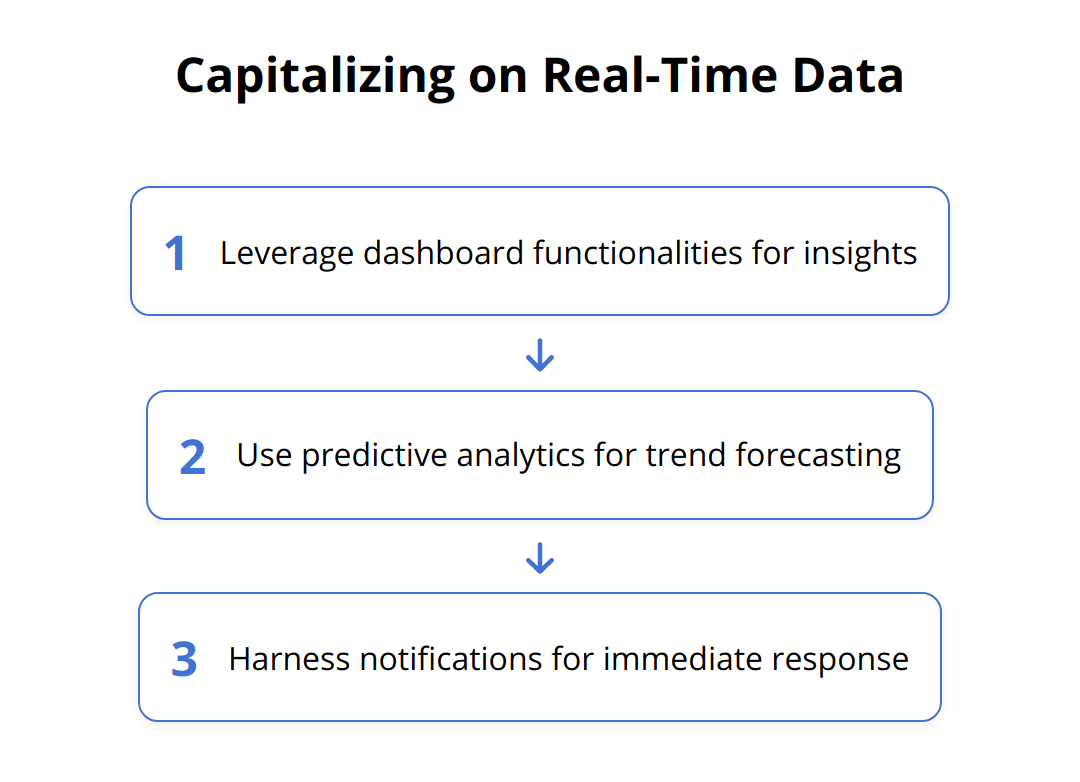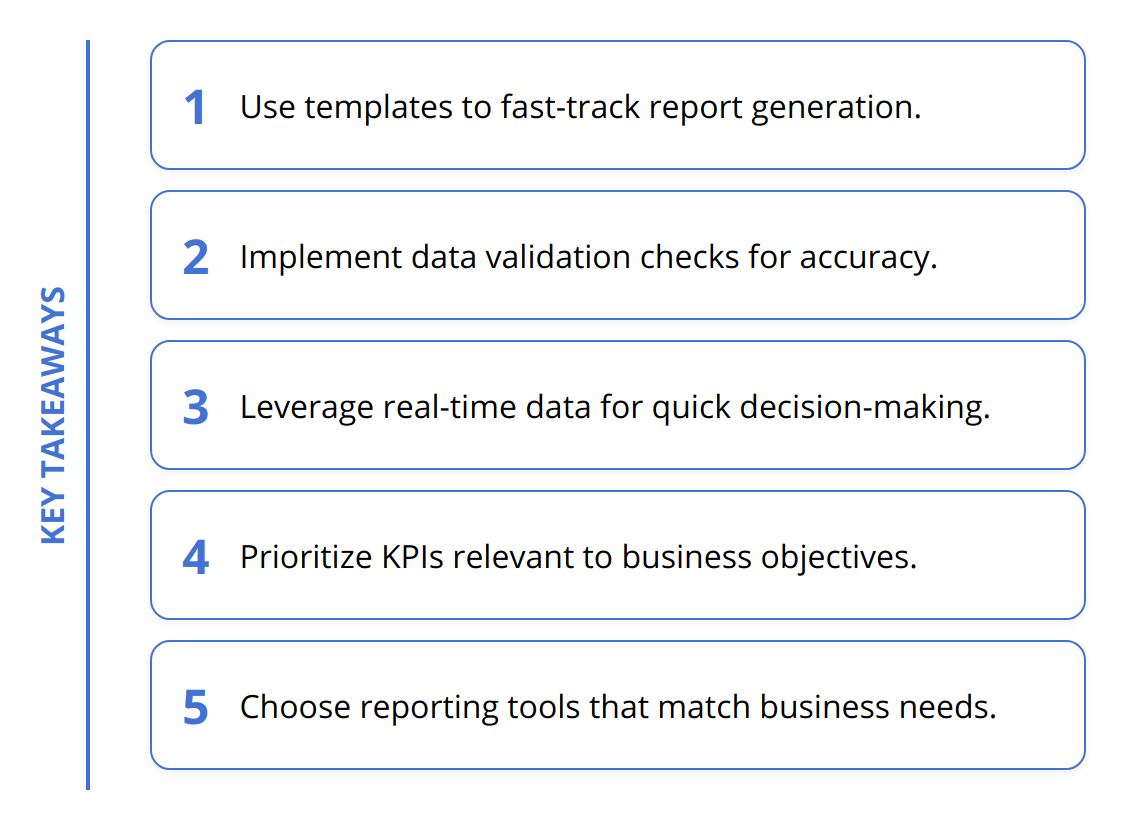Data floods into businesses daily, challenging even the most astute teams to distill insights efficiently. We at Emplibot understand how vital it is to transform raw data into strategic action. Automated reporting tools are pivotal in this transformation, offering unparalleled efficiency and clarity.
In this post, we’ll explore the fundamental roles these tools play in simplifying data analysis and enhancing business operations.
Inhalt
ToggleWhat Are Automated Reporting Tools?
Automated reporting tools are the unsung heroes in the data-driven landscape of modern business. They work quietly behind the scenes to deliver precise analysis, transforming data into actionable insights with minimal fuss. Let’s cut through the fluff and get to the heart of what makes these tools indispensable for businesses aiming to streamline their data analysis process and enhance decision-making.
Defining Automated Reports
Think of automated reporting tools as the efficient assembly lines of the data world. They collect vast amounts of information, organize it, and produce reports that are easy to understand—think clear charts and purposeful graphs. They’re designed to save time and resources by performing tasks that would otherwise take hours, if not days, when done manually. This not only speeds up the reporting cycle but also increases accuracy and consistency across reports.

The Different Types at Your Service
There’s a variety of automated reporting tools out there—each with its strengths. Code-based systems demand technical know-how but offer powerful customization for those who can handle them. Business Intelligence (BI) tools like Tableau or Power BI are workhorses for handling large volumes of data with a range of visualizations at your fingertips. Then there are dashboard tools that let you monitor real-time data, and narrative reporting tools that can articulate data findings in plain language.
Their Role in Demystifying Data
The real value of automated reporting tools lies in their ability to make sense of complex data sets quickly. No more slogging through spreadsheets or piecing together presentations. These tools do the heavy lifting, sifting through data to identify trends, patterns, and outliers. This leaves your teams free to focus on strategic analysis and making informed decisions that propel your business forward.
For an in-depth understanding of data-driven marketing tools, which often include reporting features, our article on data-driven marketing tools provides valuable insights.
So, if you’re looking to:
-
Save time with report generation,
-
Enhance the accuracy of your data,
-
Have real-time insights for agile decision-making,
Adjust your sights towards the adoption of an automated reporting tool. This isn’t just about jumping on the tech bandwagon—it’s about equipping your business with the means to operate with precision, pace, and prescience in an ever-competitive market.
How Do Automated Reporting Tools Benefit You?
Automated reporting tools offer tangible benefits that directly impact your business’s efficiency and bottom line. Here’s how these powerful tools can positively transform your operations:
Sweeping Time Savings and Productivity Boosts
Imagine cutting down the hours or even days it takes to compile reports to just minutes. Automated tools don’t tire, don’t take breaks, and they certainly don’t make errors that require double-checking. What would you do with extra hours in your workweek? Chances are, you’ll direct that time toward more strategic tasks or innovation, driving productivity through the roof.

Here are some ways to maximize time savings with these tools:
-
Schedule regular report generation at off-peak times to ensure information is ready when needed.
-
Use templates and widgets provided by the tools to avoid starting from scratch every time.
-
Set up alerts for significant data changes, so you can act promptly without constant monitoring.
Refined Data Accuracy and Minimized Errors
Human error is a reality, often leading to costly mistakes. But with automated reporting tools, this risk diminishes dramatically as processes that were once manual are now executed with machine precision. Accurate data is the lifeblood of insightful decision-making. By ensuring the numbers you base your decisions on are spotless, you’re directly influencing the potential for successful outcomes.
To enhance data accuracy, consider:
-
Employing tools that offer audit trails for full transparency and governance.
-
Implementing quality checks within the software to validate data before processing.
-
Using visualization features to spot inconsistencies or outliers that may signal data issues.
Cost Efficiency Conjoined with Agile Decision-Making
Allocating human resources to repetitive tasks is not only tedious but also costly. Automated tools liberate your team from the monotony of manual reporting, allowing them to focus on roles that add value and generate revenue. Moreover, real-time data empowers your business to make swift decisions in reaction to market trends, operational challenges, or financial forecasts.

Here are ways to capitalize on real-time data for decision-making:
-
Leverage dashboard functionalities for a 360-degree view of key performance indicators.
-
Use predictive analytics to foresee trends and take proactive measures.
-
Harness real-time notifications to stay ahead of the curve and tackle issues as they arise.
For insights into integrating your marketing automation with CRM, resulting in even greater real-time decision-making power, our guide on integration with CRM systems is invaluable.
In integrating automated reporting tools into your business strategy, you’re not just following a trend. You’re making a strategic decision to operate smarter, reduce risk, and open up a world of possibilities for growth and efficiency. Keep in mind, the next step after implementation is to ensure you’re extracting the full potential of these tools. That means ongoing evaluations, employee training, and perhaps even creating new roles dedicated to managing these powerful systems.
Integration and Adoption Strategies
The leap towards automated reporting tools can be smooth sailing if you know the ropes. Successful integration hinges on choosing metrics that matter and creating a reporting process that’s as sleek and efficient as possible.
Pinpointing Vital KPIs
The bedrock of insightful automated reports is the KPIs they track. And here’s the deal: not all KPIs are created equal. Choosing indicators relevant to your business focuses your energy on what truly drives success. This demands you have a profound understanding of your business objectives and the factors that influence these goals. Are you focused on customer retention? Then, churn rate is your beacon. Is your business modeled around revenue growth? Keep a close eye on monthly sales growth.

Tailoring Your Reporting Workflow
Having the right tools without the right techniques is like having a sports car without the keys. A scheduled, templated approach to reporting cuts through the potential chaos like a knife through butter. It’s about setting up systems that allow your data to flow into reports at regular intervals, with templates that reflect your brand’s analytic needs. This means adapting report-generating schedules to your business cycles and saving templates that hit all your reporting sweet spots.

Navigating Through Challenges
It’s not all smooth sailing, though. Data security and employee buy-in can be hefty obstacles. Tight security protocols are non-negotiable – you’re handling sensitive data that requires ironclad protection. Adoption by your team is equally vital for success. When reports roll out, everyone needs to be on board, understanding the benefits these tools bring to their roles and the broader business context. It’s about fostering a culture that values data, training staff to interpret and use automated reports effectively, and showcasing the time and effort they save.
Now to bring these best practices into the real world, think about supplementing your toolkit with further expertise in areas like marketing automation for small businesses and smart automation workflows. These resources provide actionable insights for smaller setups looking to get the hang of automation and reporting.
Remember, integrating automated reporting isn’t just a technical move; it’s a strategic maneuver that refines your business operations on every level. It’s about arming your team with the tools and know-how to slice through data with precision and speed. With the right KPIs, a streamlined process, and savvy strategies to overcome hurdles, you’ll wield these tools with mastery, ensuring your data’s story is not just heard but acted upon.
Choosing Your Reporting Toolkit
Selecting the ideal automated reporting tool for your business isn’t just about adopting technology; it’s about securing a partner that caters to your unique data reporting needs and objectives. With numerous options available, the decision can be overwhelming. Here’s how you navigate the maze of tools to find the one that fits like a glove.
Matchmaking Business Needs with Tool Features
Your business is unique, so your reporting tool should be a precise match for your specific goals and data management requirements. Start by identifying the type of data you deal with, the level of analysis needed, and the most important insights you expect to gain. Does your organization prioritize sales analytics, marketing performance, or financial reporting? Drill down into these details and the choice of tools will narrow, steering you toward a more targeted selection.
Sizing Up the Contenders
Once you know what you’re looking for, it’s time to compare the functionalities of different tools. This is not just about selecting the most advanced tool; it’s about finding the right balance of capabilities versus usability. A feature-rich tool like Tableau is perfect for data visualization enthusiasts, while Google Data Studio might suit those seeking seamless integration with other Google services. And if robust analytics coupled with ease-of-use is your game, Power BI could hit the sweet spot.
The Rollout Blueprint
After selecting the perfect tool, implementing it and getting your team up to speed is next on the agenda. A successful rollout involves clear communication, comprehensive training, and ongoing support. Develop a step-by-step implementation plan, schedule training sessions rich in actionable know-how, and provide resources that assist your team in making the most out of the new tool. It’s also key to appoint a champion—a go-to expert who can troubleshoot and advocate for the tool’s value within your organization.
For an effective introduction to Power BI and how it can enhance your reporting capabilities, our discussion on integrating marketing automation with CRM systems offers practical guidance.
Hands-on Tips for Implementation
-
Treat the tool selection process as an investment decision; consider the ROI of each option.
-
Opt for tools with excellent customer support and community forums for troubleshooting.
-
Ensure the tool scales with your business growth and data complexity.
-
Look for intuitive interfaces to accelerate the learning curve for team members.
-
Prioritize tools with robust security features to protect your data assets.
Navigating through the selection, comparison, and implementation of an automated reporting tool is a journey, not a single decision. It’s about careful planning and making informed choices that align with your business strategy and empower your team. Opt for a tool that not only reports numbers but tells the story of your data in a way that fuels informed business growth and evolution. Keep the focus on aligning tool capabilities with your needs, and you’ll set the stage for a powerful synergy of data analysis and business intelligence.
Wrapping Up
As we’ve navigated through the intricacies of automated reporting tools, it’s clear that their impact on business efficiency is profound. These tools are more than just time-savers; they are the engines that can power strategic growth and sharpen competitive edges.

Opting for automated analysis is not merely a step towards technological advancement; it’s adopting a data-driven mindset that positions a company to thrive in an increasingly analytical business environment. By automating the mundane and error-prone tasks of data reporting, businesses unlock the potential to:
-
Act on real-time insights that inform smart, agile business moves.
-
Allocate resources more effectively, carving out time for innovation and strategy.
-
Ensure data integrity, which serves as the foundation for trustworthy analytics.
Business leaders who embrace automated analysis do so knowing it’s an investment in their company’s future, a commitment to ongoing improvement and relevance. The age of data is here, and with it comes the imperative to adapt and make data work in favor of your business goals.
Now, for businesses looking to automate even further beyond reporting, consider Emplibot—a platform that takes content creation to the next level. Emplibot automates the process of publishing SEO-friendly articles, complete with keyword research and internal linking. By freeing up resources that would otherwise be spent on manual blog management, companies can focus their efforts on other strategic priorities while maintaining a strong online presence.
To discover how Emplibot can elevate your business’s content strategy with zero hassle, visit Emplibot.
In summary, the power of automated reporting tools is undeniable, offering:
-
Reduced time on report generation.
-
Increased data accuracy.
-
Better-informed decision-making.
-
Cost-efficiency.
-
Enhanced strategic business growth.
Taking the leap toward automated reporting and analysis is a sign of a forward-thinking and efficiency-driven business. It’s a strategic choice that fosters a culture of accuracy, insight, and intelligence. Let the precision and pace of automated tools propel your business into a future where decisions are empowered by data, and success is not left to chance.











